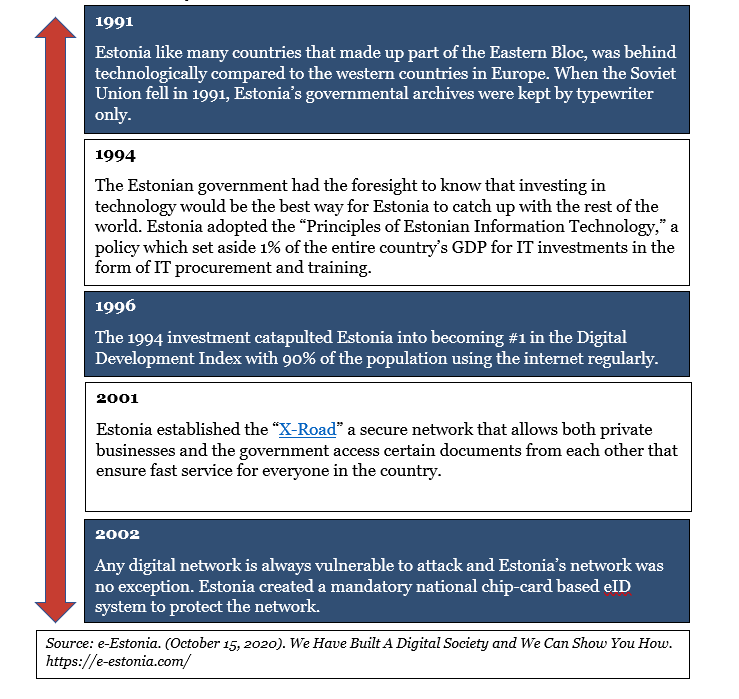
Implementing eGovernment: 3 Lessons from Estonia
October 27, 2020
State governments across the country have switched to work from home to comply with quarantine orders. This has closed some state offices, significantly reduced the hours of other state offices, and has caused wide-spread delays in citizens receiving services across the country. This has created a demand to expand eGovernment services and, according to the United Nations survey, some world governments have responded to this demand by making more government services available online. As more states expand eGovernment services, lessons can be learned from how one country went almost 100% online years ago: Estonia.
The Little Country That Could

Click here to learn more about Estonia’s “X-Road”
Troubles: The Bronze Soldier Cyber Attacks
Despite having some security features such as the eID system to protect the X-Road network, security measures proved useless against what is believed to be the first hack of a government network in history. In 2007, riots broke out between ethnic Estonians and Russians over the moving of a Soviet era statue. Simultaneously, there were cyberattacks to the X-Road network. The attack was unprecedented. The Estonian government, in a move to legitimize public trust, approached addressing the cyberattack with complete transparency.
Estonia created the Estonian Defense League’s Cyber Defense Unit, a branch of the military modeled after the American Revolution’s Minute-Men militia. When attacks occur, thousands of IT volunteer professionals can be mobilized from across the country to assist government IT professionals in stopping the attack.
|
You can learn more about block-chain technology through Procurement U’s free course on it. You can also read our previous blog on the subject.
|
On top of this immediate response system, the Estonian government adopted block-chain technology in 2008. Block-chain is a complicated network security system that today is considered the gold standard in technology security.
Estonia is now considered the gold standard on government cyber security and leads NATO’s Cooperative Cyber Defense Center of Excellence, which trains IT government officials from NATO member countries on how to best defend their networks from attacks. All these initiatives aided in restoring public trust in the Estonian eGovernment system. Currently almost all government services from voting to healthcare, prescriptions to road administration, are available online.
3 Lessons from Estonia
- Investment in technology is key
Your state might not be able to invest 1% of its GDP in IT procurement like Estonia but making the case for even an e-Procurement system in your procurement office can make a difference in saving tax-payer money. For example, switching to a digital signature system for documents in Estonia helped save the government 2% of GDP annually. This sales pitch will become crucial in the following months as state governments face budget shortfalls due to the COVID-19 Pandemic.
| If you want to learn more about e-Procurement you can start by looking at our recent webinar titled eProcurement: What It Is & What It Isn’t. |
- Get your IT partners involved
Estonia managed to create a robust eGovernment system because it allowed subject-matter expert IT officials lead government efforts to adopt the system. Who are your IT SMEs in your state? Do you have a rapport with them? If you do not know you may want to start by identifying who are the members of major technology associations in your state like NASCIO or NASTD. What are they already working on? A 2017 survey from the National Association of State Chief Information Officers (NASCIO) showed that 63% officials were already in talks with their governments on adopting block-chain cyber security. Creating that relationship and common goal can help you both advocate for better eGovernment services.
- Cyber security & transparency are at the heart of any eGovernment System
Cyber security is key to any eGovernment system. Due to political and historical reasons, no U.S. government will likely adopt a chip-card based national eID security system. However, adopting technology like block-chain and two-factor authentication can help secure your network against attack. There is opportunity here. The same 2017 survey by NASCIO shows that only 5% of state information officers reported that their governments have adopted block-chain technology. Any adaption of an eGovernment system must:
- Ensure that there is a way to identify problems
- Communicate those problems to elected government officials and the public
- Allow government a way to fix those identified problems
Although we cannot always predict what cyber security problem could come next, making sure to ask the right questions through the bidding process can help mitigate future problems.
